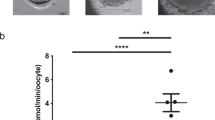Summary
The major carbon sources inXenopus oocytes and cleavage-stage embryos appear to be amino acids, which are oxidized to form pyruvate (to support the Krebs cycle) and phosphoenolpyruvate (for anabolic processes). Metabolism of various metabolites in vitro into aspartate or glutamate, and then partially into phosphoenolpyruvate, requires the presence of mitochondria, suggesting that metabolism in vivo utilizes mitochondrial enzymes. The rate limiting step in metabolism in the stage VI oocyte appears to be uptake and/or metabolism of compounds by the mitochondria; the rate of metabolism increases during maturation. During early cleavage no qualitative differences in metabolism were observed either as a function of development, or spatially along the animal/vegetal or prospective dorsal/ventral axes.
Similar content being viewed by others
References
Barnes MR (1944) The metabolism of the developingRana pipiens as revealed by specific inhibitors. J Exp Zool 95:399–418
Barth LG (1942) Regional differences in oxygen consumption of the amphibian gastrula. Physiol Zool XV:30–48
Black SD (1989) Experimental reversal of the normal dorsal-ventral timing of blastopore formation does not reverse axis polarity inXenopus laevis embryos. Dev Biol 134:376–381
Brachet J (1939) Etude du métabolisme de l'oeuf de Grenouille (Rana fusca) au course du développement. Arch de Biol 50:233–267
Dworkin MB, Dworkin-Rastl E (1989) Metabolic regulation during early frog development: glycogenic flux inXenopus oocytes, eggs, and embryos. Dev Biol 132:512–523
Dworkin MB, Dworkin-Rastl E (1990) Regulation of carbon flux from amino acids into sugar phosphates inXenopus embryos. Dev Biol 138:177–187
Eppig JJ Jr, Dumont JN (1972) Amino acid pools in developing oocytes ofXenopus laevis. Dev Biol 28: 531–536
Halestrap AP, Denton RM (1974) Specific inhibition of pyruvate transport in rat liver mitochondria and human erythrocytes by α-cyano-4-hydroxycinnamate. Biochem J 138:313–316
Jaeger L (1945) Glycogen utilization by the amphibian gastrula in relation to invagination and induction. J Cellular Comp Physiol 25:97–120
Kao KR, Masui Y, Elinson RP (1986) Lithium-induced respecification of pattern inXenopus laevis embryos. Nature 322:371–373
Løvtrup-Rein H, Nelson L (1982) Changes in energy metabolism during the early development ofXenopus laevis. Expt Cell Biol 50:162–168
Salomón de Legname H (1969) Biochemical studies on the energetics ofBufo arenarum segmenting eggs. Arch Biol [Liège] 80:471–490
Salomón de Legname H, Sánchez Riera AN, Sánchez SS (1975) Source of precursors for nucleotide biosynthesis inBufo arenarum segmenting eggs. Acta Embryol Exp 2:123–136
Shiokawa K, Tashiro K, Atsuchi Y, Kawazoe Y (1986) Alteration of the pool of free amino acids during oogenesis, oocyte maturation and embryogenesis of Xenopus laevis andXenopus borealis. Zool Sci 3:793–799
Taylor MA, Smith LD (1987) Accumulation of free amino acids in growingXenopus laevis oocytes. Dev Biol 124:287–290
Thoman M, Gerhart JC (1979) Absence of dorsal-ventral differences in energy metabolism in early embryos ofXenopus laevis. Dev Biol 68:191–202
Vincent J-P, Oster GF, Gerhart JC (1986) Kinematics of gray crescent formation in Xenopus eggs: the displacement of subcortical cytoplasm relative to the egg surface. Dev Biol 113: 484–500
Author information
Authors and Affiliations
Rights and permissions
About this article
Cite this article
Dworkin, M.B., Dworkin-Rastl, E. The involvement of mitochondria in carbon metabolism in cleavingXenopus embryos. Roux's Arch Dev Biol 200, 51–57 (1991). https://doi.org/10.1007/BF02457641
Received:
Accepted:
Issue Date:
DOI: https://doi.org/10.1007/BF02457641




